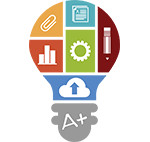What is eLearning?
eLearning is the use of media, information, and technology to create electronic education. These educational solutions help your curriculum, course, presentation, or product reach and speak to your audience. Who needs to create eLearning? Almost anyone who needs to explain something to someone.
Sometimes you may need to create a stand alone course that takes someone from start to finish through a given topic. Sometimes you may need more complex knowledge checks, simulations, or games that let someone test their knowledge or develop experience. And sometimes you may need educational tools, reference, and aids during a presentation. This is often called blended learning. Sometimes you may need to train one person at a time, sometimes many. Here are a few examples of what training is used for:
New hire training
Compliance training
Sales and marketing training
Medical device showcasing
Management/leadership training
Safety training
CME and CE accreditation
Education preparation training
Training on a specific process and process exceptions
K-12 and College level education
Make eLearning Interesting
 If you have ever sat down at a computer to learn something new you may have crossed your fingers and hoped it would be interesting. Falling asleep while clicking through information is not going to help someone understand and retain what they learned. So we recommend finding ways to add energy to information, ways to challenge the learner, ways to express cause and effect, and ways to truly prepare the learner for what is in store for them past the learning project.
If you have ever sat down at a computer to learn something new you may have crossed your fingers and hoped it would be interesting. Falling asleep while clicking through information is not going to help someone understand and retain what they learned. So we recommend finding ways to add energy to information, ways to challenge the learner, ways to express cause and effect, and ways to truly prepare the learner for what is in store for them past the learning project.
Content
 Content is what everything else orbits around. Content is the information or material that provides what the learner must know to meet the objectives of the course. What is it really that someone needs to get out of your learning course? Keep in what is important and remove what isn't. This might be text, images, videos, or even simulations that force or guide the the user to make decisions and solve problems.
Content is what everything else orbits around. Content is the information or material that provides what the learner must know to meet the objectives of the course. What is it really that someone needs to get out of your learning course? Keep in what is important and remove what isn't. This might be text, images, videos, or even simulations that force or guide the the user to make decisions and solve problems.
Audience
 Who is going to be using or viewing your eLearning project? How good are they at using technology? What vocabulary are they familiar with? How much time do they have to spend on education and training? What do they already know about the given topic? Develop your project to the answers these questions provide. It will increase the experience your audience has.
Who is going to be using or viewing your eLearning project? How good are they at using technology? What vocabulary are they familiar with? How much time do they have to spend on education and training? What do they already know about the given topic? Develop your project to the answers these questions provide. It will increase the experience your audience has.
It's Vocab Time
Let's take a quick second (or two) to talk about some common terms you will often see when developing eLearning projects.
Knowing these terms will make sure you and everyone else working on a project are speaking the same language.
The Subject Matter Expert is not just the keeper of the material, but also the person who understands the material. They are often the Instructional Designer's and User Experience Designer's first stop in understanding the course information and the audience that will become the learners.
A SME is often a client who is greatly familiar with the material, but can be anyone who is familiar enough with the nature of the materials and those who will view the final project.
An Instructional Designer needs to be a good writer, understand the learner’s abilities and limitations, be good at developing learning plans, working with Subject Matter Experts, or SMEs, and be flat out awesome at understanding what makes content educational to meet the needs of both the learner and the course provider.
There are many types of Learning Management Systems. Some are simple some are complex. Some even allow you to charge for each course.
Many tools output SCORM, AICC, and TinCan API with a simple check of a box, and custom solutions can be programmed to be SCORM compliant. The developer just needs to know what is required.
Levels of Engagement
Within eLearning there is a general guide to the levels of interaction a project contains. Each level increases the amount of engagement, interaction, and complexity. The level is often determined by the audience, nature of the content, importance of user application of the content, and the budget.
Level 1 – Passive Interaction - Screen by screen or video with no real interaction
Level 2 – Limited Interaction - Simple interactions such as multiple choice and popup information
Level 3 – Moderate Interaction - More complex interactions such as drag and drop. Interaction has more logic and visuals
Level 4 – Simulation or Realtime Interaction - Highest level of interaction using complex, logic based simulations, games, or tools using high visuals, often putting a user in an environment
Learning Management System
A Learning Management System (LMS) can be just as important to course Administrators and Trainers as the content is to the learner. An LMS is usually a website-based system for Course Administrators and Trainers to manage users, performance, and content. It is often said that content is a key, but in reality, there are many other considerations that need to be working together for a learning solution to function for the benefit of all parties. An LMS navigates a learner to available learning modules and it groups those modules into a curriculum. User management is structured for learners, who they are, their level of course/lesson access, their assessment scores, and number of times the course has been accessed, to name a few. There are many more aspects to the features, benefits, and functionality of an LMS.
Before moving forward, we recommend sitting down with your team and drawing out what your training needs are. Pretend you are a learner. This is called defining a persona. Pretend you are the administrator, and discuss how you plan to manage courses and users. You might not have all the answers, but it will certainly provide a direction and a warehouse full of questions.
Knowledge Checks, Assessments, and Surveys
There are many ways to document and display in measurable terms, the understanding, knowledge, skills, and attitudes of information, processes, and concepts.
Knowledge Checks
Knowledge Checks allow learners the ability to test themselves. How well do they know the material? How well can they apply the material? Do they know enough to continue on through the course? Knowledge checks can be delivered as multiple choice and fill in the blank tests, ordering metrics, drag and drop, interactive simulations, games, and advanced decision tree methods.
Assessments
Assessments allow a facilitator the ability to understand how well a learner comprehends and applies the information they have learned. This data can be gathered and stored. While many assessments are multiple choice, true and false, or fill in the blank, like knowledge checks, simulations and a wide variety of other methods can be used to assess they learner. Assessment questions can be randomized to reduce answer memorization and cheating.
Surveys
Surveys are a great way for a facilitator or administrator to understand what a learner thinks of the content, how it is presented, how they feel they comprehended it, and methods of improvement. Surveys are sometimes placed after an assessment but can be provided to the learner in many ways. The survey data is used to vet the course against the objectives, check for development errors, and find potential future upgrades to the material.
Languages and Culture
Putting It All Together - The Process
Illumen’s process for developing learning modules is really about how our clients, subject matter experts, instructional designers, creative directors, testers, and of course learners, interact with each other throughout the development process. We have determined the following to be our general process for developing powerful learning modules:
1. Need - Define the need for the module.
2. Plan - You know why, now focus on how this module will be put together.
3. Content - The subject matter expert and instructional designer begin to develop content.
4. Experience - As the content comes together, the creative director defines the user experience with the team.
5. Develop - The developers bring the content to life screen by screen.
6. validate - Quality assurance and pilot testing check the project against the plan and need.
7. Launch - With everything in check, the project launches and the learners learn.
8. Future - As time moves on, changes and updates are made as needed, continuing the process over.
